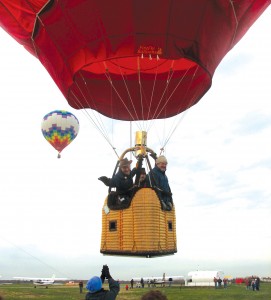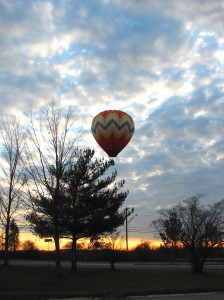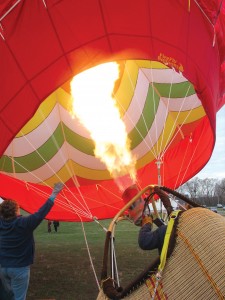By Rebecca Becker-Bean

A basic AX-7 balloon system costs about $30,000, but related equipment (the “chase vehicle,” radio systems, ropes, rack, etc) adds to the cost. When all is said and done, the Youngs show up for a balloon flight with about $100,000 of equipment.
In 1793, President George Washington gave French balloonist Jean Pierre Blanchard a letter of safe conduct. The Frenchman took off from the federal prison yard in Philadelphia, Penn., and landed on a farm in Deptford, N.J. Blanchard had, in effect, flown the first airmail letter in the United States, to New Jersey.
Thirty-seven years later, in 1830, American born Charles F. Durant of Jersey City, N.J., took off in a balloon and landed on a New Jersey farm. Today, ballooning, the oldest form of human aviation, is still going on in New Jersey.
Ballooning may not be as common as it once was, but to those who fly balloons, it’s a magical experience. Dick and Mary Beth Young, of Parsippany, N.J., discovered the magic of hot air ballooning in 1977, when they happened upon the Adirondack Balloon Festival in Glens Falls, N.Y. One of the balloonists saw their interest and welcomed them over to his balloon. They ended up taking a tethered ride that day (a balloon ride to a fixed height, while a rope secures the balloon in place).
“There’s something special going on here,” Dick Young told his wife as their eyes met. They both knew instantly that ballooning was more than just a fun event; it would go on to be life-changing for them.
That proved to be true. The Youngs are now FAA-certified commercial balloon pilots who also provide student flight instruction at multiple flight locations in New Jersey, Pennsylvania, New York and Vermont. Involved in ballooning for nearly three decades, the Youngs offer balloon flights to individual and commercial customers through their company, A Beautiful Balloon, located in Parsippany, N.J. A Beautiful Balloon provides a variety of ballooning events, including romantic champagne flights, tethered rides and “balloon glows”— lighting up a colorful balloon at night. But the Youngs’ greatest joy is taking others on their first balloon ride.

Dick Young and his wife attend several festivals each year, launching their balloon en masse with many others.
“Most people don’t realize the awesome feeling of a hot air balloon ride,” explains Dick Young. “As a crewmember says, ‘It feels like you’re standing on a balcony with a railing, watching the earth pass beneath you. There’s no breeze, because you’re one with the wind.'”
To prepare for a flight, the crew first spreads the balloon fabric on the ground. Then the pilot opens the throat of the balloon and turns on a gasoline-powered fan to fill the balloon with air. Next, the propane-fueled burner heats the air inside the balloon within minutes, and the balloon begins to stand upright. The pilot and passengers board the basket as the pilot continues heating the air inside the balloon. It’s almost launch time.
While the passenger basket hovers just above the ground, the crewmembers lean all their weight on it, to anchor the balloon until the air inside is hot enough to rise. “Hands Off!” the pilot finally announces. The crew steps back and the balloon rises up and away!
The lift strength of the Young’s hot air balloon system is surprisingly strong—a total of 1,750 pounds. The balloon envelope fabric weighs about 200 pounds. The basket—loaded with 30 gallons of liquid propane fuel—weighs about 375 pounds. This leaves a “free lift” capacity of nearly 1,200 pounds for carrying passengers.

When balloons are ascending en masse, pilots typically ascend at less than 200 feet per minute, or about two miles per hour. The pilots who are above must watch for rising balloons, since the pilot below can’t see through the top of the balloon.
As the balloon floats across the landscape, passengers experience the “magic carpet ride” of ballooning. Some people enjoy talking to the pilot about how the balloon works, where they are going and what will come next. Others, enthralled with the magic of floating high above the earth, simply absorb the beauty unfolding below them. Many passengers have later contacted the Youngs to say, “We’ve never experienced anything so thrilling and so beautiful.”
Despite their love for ballooning, the Youngs decided long ago not to make their passion into a livelihood.
“We don’t want to do this full time,” explained Young. “There’s too much pressure to fly in adverse weather conditions.if you’re trying to pay the mortgage.”
Safety is indeed the cornerstone of their company.
“Our first safety priority is passenger safety; if the weather conditions aren’t just right, we’ll wait until another day,” he said. “Our second priority is aircraft safety. We thoroughly inspect the balloon fabric and our flying systems before we fly. Finally, we consider the convenience of our crew.”
When they fly, the Youngs particularly enjoy celebrating special occasions with their passengers. People schedule balloon champagne flights to mark birthdays, anniversaries and wedding engagements.
“One young man had his marriage proposal well planned,” Young said. “He had arranged to bring a special bottle of wine on the flight. He and I had agreed that I’d use some code words to let him know the appropriate time to present the wine bottle to his girlfriend.”

As with all hot air balloonists, the Youngs usually fly at sunrise or before sunset, when the winds are most stratified and gentle. Balloonists seek to fly when winds at the ground surface are about three to seven miles per hour.
Unfortunately, Young explains, the young man became so enraptured with the flight that he missed the many cues that Young gave him, like, “Well, we’re only half an hour away from landing,” and “We’re about ten minutes from our flight’s end.” Finally, Young said loudly, “Well, folks, we’ll start our descent to land now,” and the young man suddenly realized that his last chance was slipping away. He jumped up to present the special wine bottle to his girlfriend. The label on the wine bottle read: “Jen, will you marry me?” His girlfriend squealed with excitement and hugged him with an enthusiastic ‘Yes!'”
On one recent flight, the Youngs had floated over the countryside for about an hour. As they were approaching an open field, they passed over a large home. Suddenly, the door burst open, and a woman came running toward the balloon, with a group of children in tow.
“Land here!” she cried, “I have the champagne!” Sure enough, she had a bottle of champagne and a stack of cups tucked under her arm! A festive celebration soon followed the balloon landing.
When the balloon ride comes to its end, the landing is exciting, because the location is always a function of the wind. At landing time, the pilot begins to scan the surrounding terrain for spacious fields. Once he chooses a landing area, the pilot then calls his “chase crew” (in a nearby vehicle) to notify them that he is landing.
Then the crew parks their vehicle and runs toward the balloon, gently grasping the passenger basket by its handles as it floats within reach. Sometimes it’s necessary for the crew to “walk” the balloon to the widest part of the field, while it’s still a few feet above ground. Once at its landing destination, the balloon gently settles to earth as the air within it cools.

Mary Beth Young holds open the throat of the balloon while Dick Young heats the air with a propane burner. The burner emits 17 million BTUs per hour—roughly equivalent to the heat output of about 170 home furnaces.
But the excitement isn’t over yet. The Youngs sometimes land their balloon in open fields that adjoin roadways and homes. Cars stop along the roadside below, and people watch the balloon descend. As the balloon settles to earth, people often pour out from the nearby streets and houses to see the spectacle.
“That’s when real human connections are made,” Young says. “The landowners and the neighbors crowd around, asking the crew questions, and we have the chance to talk to the crowd about ballooning.”
Young said that people who have been neighbors for years and haven’t really spoken to one another now have a catalyst for conversation.
“If weather conditions allow, we’ll frequently offer them tethered balloon rides, and we let them help pack up the balloon, if they wish,” he said.
Finally, the Youngs host a champagne celebration to toast the occasion.
“A balloon flight isn’t like a Disney World ride that will happen the same way every time,” Young explains. “It’s a magical moment, a unique experience that will never unfold in quite the same way again.”
For more information, visit [http://www.balloon-rides.com]. You can contact Dick and Mary Beth Young at 973-335-9799 or by email at balloonsnj@aol.com.











